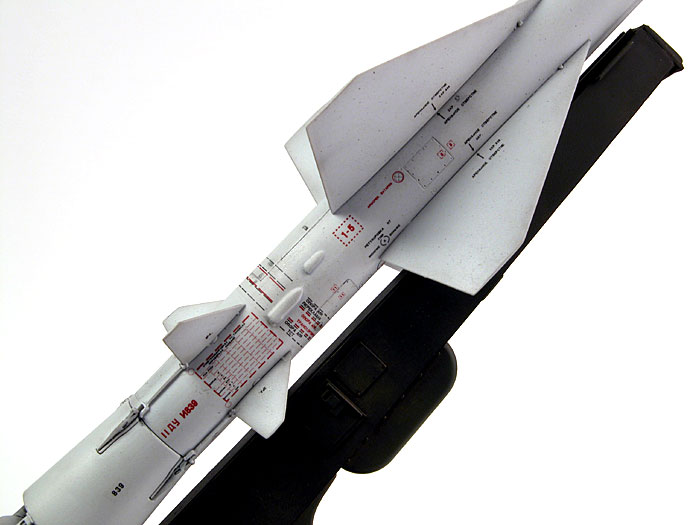Model built by Chris Wauchop

HyperScale is proudly supported by Squadron.com
"Ban Roi Tai Cho! Bat Xong Giac Lai!" In 1972, that was the motto of the
Vietnamese Peoples' Air Force Air Defense: – shoot down the airplanes on the
spot! capture the pirate pilot alive! And the weapon that gave that to many VPAF
units was the S-75 air defense missile system firing the V-750 surface-to-air
missile – the SA-2 GUIDELINE to NATO, the "Flying Telephone Pole" to US pilots.
The S-75 was created by the USSR in the mid 1950s in response to a requirement
to create a B-52 killing mobile missile system in which a battery could be set
up (radar, fire control van, and six launchers) in less than 4 hours and ready
to engage the enemy in no more than 9. The first system, the SA-75 "Dvina", was
a fixed system accepted for service in December 1957. Later, first the mobile
S-75 "Desna,", was accepted for service in May 1959, and an improved version,
the S-75M "Volkhov," followed in April 1961. All of them used first the SM-63
and later the SM-90 launcher mount, developed by TsKB-34, and based upon an
antiaircraft artillery platform.
There were a number of different versions of the missile produced: V-750 (1D),
V-750V (11D), V-750VN (13D); V-755 (20D/20DP), and 5Ya23. All were approximately
the same size with different warhead sizes (the 5Ya23 was reportedly a bomber
formation killer with a nuclear warhead) and ranges. The S-75M had a range of
engagement from 7 to 43 kilometers and an altitude of engagement of 100 to
30,000 meters. Targets were engaged by the radar (FAN SONG to NATO) and 1 to 3
missiles could be fired at a single target.
The missiles had to be guided to the target by the radar, and hence when the
USAF developed the "Wild Weasel" that shot back with the Shrike or Standard ARM
missile it became a game of "Guts" as to who would win. The Shrike had to have
an active target, so the trick was to see who figured his missile would hit the
other guy first; if the radar shut down the Shrike would usually miss, but if
the radar shut off the missiles would never hit their intended aerial target.
Most SA-2s are out of the inventory except in many third-world nations, and the
Chinese have worked to continually improve their CSA-1 versions of the missile.
But during the 1960s and 1970s, the SA-2 was the most widely exported – and used
– surface-to-air missile in the world.
Trumpeter has now released a gorgeous pair of kits – the SA-2 missile on its
launcher, and an SA-2 on a reloader/transporter trailer towed by either a
Chinese truck or a Soviet era ZIL-157L. The ground kit appears to represent the
basic model of the V-755 "Volkhov" version of the system and the SM-90 launcher
mount. Both are very nicely done and an impressive amount of parts is provided
to build both the launcher and the missile.
The missile consists of 40 parts, and is built in sub-assemblies of missile and
booster. The missile is complete down to the external control actuators for the
airfoil controls and main engine gimbals . A very nicely done decal sheet
provides all of the Cyrillic stencils used by the Soviets, so it pretty much
limits the missile as it comes out of the kit to a Soviet-built version. (Some
export models had text in English; this isn't one of them.)

The launcher is very well detailed and provides a lot of moving parts to ensure
that it faithfully duplicates the original. There are a large number of
hydraulic pistons, and this requires care as the directions are a bit breezy
about what they are and where they go. The kit indicates the elevation arm
elevates, but as everyone who has ever built a model with working parts and
weight at the end of an action arm knows, you need either friction or a lock to
hold it in place. There is also a gear assembly (Part P16) as part of the
elevation mechanism that is cemented in place, but as I have not assembled the
kit yet I do not know if it functions as a friction snubber or or not.
Alas, no bogies are provided for the carriage, so there is no way to show the
launcher and a racked-up missile in transit, or to show the launcher during
emplacement or being prepared to move. Trumpeter also does not offer the FAN
SONG radar van, but that may be just as well: a full fledged SA-2 battery site
in 1/35 scale would be about 30' in diameter, not something easily shown to
one's friends or taken to competitions!
Overall this is a great kit, but I think Trumpeter has a rather ironic sense of
humor releasing it at the same time as a 1/32 scale F-105D – one of the SA-2's
main targets in Vietnam!
Cookie Sewell
AMPS
Review Copyright © 2003 by Cookie
Sewell
Model by Chris Wauchop
Images
Copyright © 2003 by Brett Green
Page Created 07 November, 2003
Last updated 07 November, 2003
Back to HyperScale
Main Page
Back to Reviews
Page
Home | What's
New | Features
| Gallery |
Reviews | Reference
| Forum
| Search